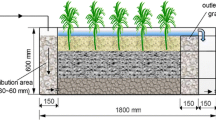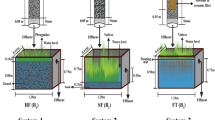Abstract
Pilot-scale experiments were performed to investigate the role of equalization basins used with constructed wetland systems for treatment of flue gas desulfurization (FGD) waters. Analysis of FGD water samples indicated that aqueous concentrations of Hg, As, and Se remained constant or changed very slightly in a pilot-scale equalization basin during a 24-h hydraulic retention time (HRT). No change in toxicity of FGD water occurred after one HRT. FGD particles were predominantly silt size, and approximately 99% of particles suspended in FGD water settled to the bottom of a 2.5-m-deep equalization basin during the first 4 h of the 24-h HRT. Approximately 90% of the total As, and smaller percentages of Hg and Se, in FGD water and particles were removed by particle settling in the equalization basin. Results of this investigation lend support to the use of equalization basins for treating FGD waters in constructed wetland treatment systems.





Similar content being viewed by others
References
American Public Health Association (APHA), American Water Works Association, and Water Pollution Control Federation (1998). Standard methods for examination of water and wastewater (20th ed.). Washington, DC: American Public Health Association.
American Society for Testing and Materials (ASTM) (2001a). D445 standard test method for kinematic viscosity of transparent and opaque liquids (the calculation of dynamic viscosity). Annual Book of ASTM Standards, Petroleum Products, Lubricants, and Fossil Fuels, 5, 185–193.
American Society for Testing and Materials (ASTM) (2001b). D446 standard specifications and operating instructions for glass capillary kinematic viscometers. Annual Book of ASTM Standards, Petroleum Products, Lubricants, and Fossil Fuels, 5, 194–216.
Barton, C. D., & Karathanasis, A. D. (1998). Aerobic and anaerobic metal attenuation processes in a constructed wetland treating acid mine drainage. Environmental Geosciences, 5, 43–56. doi:10.1046/j.1526-0984.1998.08010.x.
Cronk, J. K. (1996). Constructed wetlands to treat wastewater from dairy and swine operations: A review. Agriculture Ecosystems & Environment, 58, 97–114. doi:10.1016/0167-8809(96)01024-9.
Eggert, D. A., Rodgers, J. H. Jr., Huddleston, G. M., & Hensman, C. E. (2008). Performance of pilot-scale constructed wetland treatment systems for flue gas desulfurization waters. Environmental Geosciences, 15, 115–129. doi:10.1306/eg.07050707007.
Fagerstrom, T., & Jernelov, A. (1972). Some aspects of the quantitative ecology of mercury. Water Research, 6, 1193–1202. doi:10.1016/0043-1354(72)90019-X.
Folk, R. L. (1980). Petrology of sedimentary rocks. Austin: Hemphill.
Frandsen, J. B. W., Kiil, S., & Johnsson, J. E. (2001). Optimisation of a wet FGD pilot plant using fine limestone and organic acids. Chemical Engineering Science, 56, 3275–3287. doi:10.1016/S0009-2509(01)00010-0.
Gee, G. W., & Bauder, J. W. (1986). Particle-size analysis. In A. Klute (Ed.), Methods of soil analysis, part I—physical and mineralogical methods (2nd ed., pp. 383–411). Madison: American Society of Agronomy.
Gillespie, W. B. Jr., Hawkins, W. B., Rodgers, J. H. Jr., Cano, M. L., & Dorn, P. B. (2000). Transfers and transformations of zinc in constructed wetlands: mitigation of a refinery effluent. Ecological Engineering, 14, 279–292. doi:10.1016/S0925-8574(98)00113-X.
Hatanpää, E., Kajander, K., Laitinen, T., Piepponen, S., & Revitzer, H. (1997). A study of trace element behavior in two modern coal-fired power plants, I. Development and optimization of trace element analysis using reference materials. Fuel Processing Technology, 51, 205–217. doi:10.1016/S0378-3820(97)00006-4.
Hawkins, W. B., Rodgers, J. H. Jr., Gillespie, W. B. Jr., Dunn, A. W., Dorn, P. B., & Cano, M. L. (1997). Design and construction of wetlands for aqueous transfers and transformations of selected metals. Ecotoxicology and Environmental Safety, 36, 238–248. doi:10.1006/eesa.1996.1505.
Huddleston, G. M., & Rodgers, J. H. Jr. (2008). Design of a constructed wetland treatment system for treatment of copper-contaminated wastewater. Environmental Geosciences, 15, 9–19. doi:10.1306/eg.07250707006.
Johnson, B. M., Kanagy, L. E., Rodgers, J. H. Jr., & Castle, J. W. (2008). Feasibility of a pilot-scale hybrid constructed wetland treatment system for simulated natural gas storage produced waters. Environmental Geosciences, 15, 91–104. doi:10.1306/eg.06220707004.
Kanagy, L. E., Johnson, B. M., Castle, J. W., & Rodgers, J. H. Jr. (2008). Design and performance of a pilot-scale hybrid constructed wetland treatment system for natural gas storage produced water. Bioresource Technology, 99, 1877–1885. doi:10.1016/j.biortech.2007.03.059.
Karies, C. L., Schroeder, K. T., & Cardone, C. R. (2006). Mercury in gypsum produced from flue gas desulfurization. Fuel, 85, 2530–2536. doi:10.1016/j.fuel.2006.04.027.
Knight, R. L., Kadlec, R. H., & Ohlendorf, H. M. (1999). The use of treatment wetlands for petroleum industry effluents. Environmental Science & Technology, 33, 973–980. doi:10.1021/es980740w.
Kost, D. A., Bigham, J. M., Stehouwer, C., Beeghly, J. H., Fowler, R., Traina, S. J., et al. (2005). Chemical and physical properties of dry flue gas desulfurization products. Journal of Environmental Quality, 34, 676–686.
Krumbein, W. C. (1936). Application of logarithmic moments to size frequency distribution of sediments. Journal of Sedimentary Petrology, 6, 35–47.
Laperche, V., & Bigham, J. M. (2002). Quantitative, chemical, and mineralogical characterization of flue gas desulfurization by-products. Journal of Environmental Quality, 31, 979–987.
Lewis, P. A., Klemm, D. J., Lazorchak, J. M., Norberg-King, T. J., Peltier, W. H., & Heber, M. A. (1994). Short-term methods for estimating the chronic toxicity of effluent and receiving waters to freshwater organisms, 3rd edition. US Environmental Protection Agency, EPA/600/4-91/002.
Masscheleyn, P. H., & Patrick, W. H. (1993). Biogeochemical processes affecting selenium cycling in wetlands. Environmental Toxicology and Chemistry, 12, 2235–2243. doi:10.1897/1552-8618(1993)12[2235:BPASCI]2.0.CO;2.
McCarthey, J., Dopatka, J., Mardini, R. H., Rader, P., & Bussell, C. (2005). Duke power WFGD retrofit program: compliance via standardization and selective site-specific innovations, POWER-GEN International 2005. Las Vegas, NV, 29 p. http://www.power.alstom.com/home/events/past_events/power_gen_international/_files/file_20379_56769.pdf. Accessed 2 May 2007.
Metcalf and Eddy, Inc. (1991). Wastewater engineering: treatment, disposal, and reuse (3rd ed.). New York: McGraw-Hill.
Mierzejewski, M. K. (1991). The elimination of pollutants from FGD waters. The 1991 SO2 Control Symposium, Washington D.C., pp. 20.
Mooney, F. D., & Murray-Gulde, C. L. (2008). Constructed treatment wetlands for flue gas desulfurization waters: Full-scale design, construction issues, and performance. Environmental Geosciences, 15, 131–141. doi:10.1306/eg.09200707011.
Murray-Gulde, C., Heatley, J. E., Karanfil, T., Rodgers, J. H. Jr., & Myers, J. E. (2003). Performance of a hybrid reverse osmosis-constructed wetland treatment system for brackish oil field produced water. Water Research, 37, 705–713. doi:10.1016/S0043-1354(02)00353-6.
Murray-Gulde, C. L., Bearr, J., & Rodgers, J. H. Jr. (2005). Evaluation of a constructed wetland treatment system specifically designed to decrease bioavailable copper in a waste stream. Ecotoxicology and Environmental Safety, 61, 60–73. doi:10.1016/j.ecoenv.2004.12.020.
Murray-Gulde, C. L., Bridges, W. C., & Rodgers, J. H. Jr. (2008). Evaluating performance of a constructed wetland treatment system designed to decrease bioavailable copper in a waste stream. Environmental Geosciences, 15, 21–38. doi:10.1306/eg.07110707008.
Rodgers, J. H. Jr., & Castle, J. W. (2008). Constructed wetland treatment systems for efficient and effective treatment of contaminated waters for reuse. Environmental Geosciences, 15, 1–8. doi:10.1306/eg.11090707019.
Srivastava, R. K. (2000). Controlling SO2 emissions: A review of technologies. United States Environmental Protection Agency Technical Report EPA/600/R-00/093. 100 p.
Steel, E. W., & McGhee, T. J. (1979). Water supply and sewerage. New York: McGraw-Hill.
United States Department of Energy (USDOE). (2001). Analysis of strategies for reducing multiple emissions from electric power plants: sulfur dioxide, nitrogen oxides, carbon dioxide, and mercury and a renewable portfolio standard: SR/OIAF/2001-03.
United States Environmental Protection Agency (USEPA). (1975). Process design manual for suspended solids removal. EPA 625/1-75-003a.
United States Environmental Protection Agency (USEPA). (2003). Air pollution control technology fact sheet. EPA-452/F-03–034.
United States Environmental Protection Agency (USEPA). (2004). National pollutant discharge elimination system: view NPDES individual and general permits. http://cfpub.epa.gov/npdes/permitissuance/genpermits.cfm. Accessed 1 May 2007.
Watson, J. T., Reed, S. C., Kadlec, R. H., Knight, R. L., & Whitehouse, A. E. (1989). Performance expectations and loading rates for constructed wetlands. In D. A. Hammer (Ed.), Constructed wetlands for wastewater treatment municipal, industrial and agricultural (pp. 319–355). Chelsea: Lewis.
WEF (Water Environment Federation) and ASCE (American Society of Civil Engineers). (1992). Design of municipal wastewater treatment plants: Volume 1.
Wentworth, C. K. (1922). A scale of grade and class terms for clastic sediment. The Journal of Geology, 30, 377–393.
Acknowledgments
Funding for this research was provided by the US Department of Energy through the University Coal Research Program, contract DE-FG26-05NT42535. The authors would like to thank ENTRIX, Dr. D. Bruce, and Dr. W. Chao (both of Clemson University) for their involvement with the project. We acknowledge the helpful and insightful comments of two anonymous reviewers.
Author information
Authors and Affiliations
Corresponding author
Rights and permissions
About this article
Cite this article
Iannacone, M.M., Castle, J.W. & Rodgers, J.H. Role of Equalization Basins of Constructed Wetland Systems for Treatment of Particulate-Associated Elements in Flue Gas Desulfurization Waters. Water Air Soil Pollut 203, 123–137 (2009). https://doi.org/10.1007/s11270-009-9996-9
Received:
Accepted:
Published:
Issue Date:
DOI: https://doi.org/10.1007/s11270-009-9996-9




